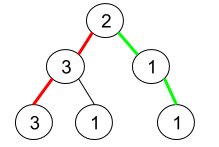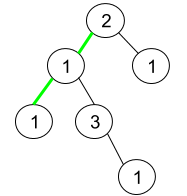| comments | difficulty | edit_url | rating | source | tags | |||||
|---|---|---|---|---|---|---|---|---|---|---|
true |
Medium |
1405 |
Weekly Contest 190 Q3 |
|
Given a binary tree where node values are digits from 1 to 9. A path in the binary tree is said to be pseudo-palindromic if at least one permutation of the node values in the path is a palindrome.
Return the number of pseudo-palindromic paths going from the root node to leaf nodes.
Example 1:
Input: root = [2,3,1,3,1,null,1] Output: 2 Explanation: The figure above represents the given binary tree. There are three paths going from the root node to leaf nodes: the red path [2,3,3], the green path [2,1,1], and the path [2,3,1]. Among these paths only red path and green path are pseudo-palindromic paths since the red path [2,3,3] can be rearranged in [3,2,3] (palindrome) and the green path [2,1,1] can be rearranged in [1,2,1] (palindrome).
Example 2:
Input: root = [2,1,1,1,3,null,null,null,null,null,1] Output: 1 Explanation: The figure above represents the given binary tree. There are three paths going from the root node to leaf nodes: the green path [2,1,1], the path [2,1,3,1], and the path [2,1]. Among these paths only the green path is pseudo-palindromic since [2,1,1] can be rearranged in [1,2,1] (palindrome).
Example 3:
Input: root = [9] Output: 1
Constraints:
- The number of nodes in the tree is in the range
[1, 105]. 1 <= Node.val <= 9
A path is a pseudo-palindromic path if and only if the number of nodes with odd occurrences in the path is
Since the range of the binary tree node values is from
Based on the above analysis, we can use the depth-first search method to calculate the number of paths. We define a function
The execution logic of the function
If
Otherwise, let
If
If
The time complexity is
# Definition for a binary tree node.
# class TreeNode:
# def __init__(self, val=0, left=None, right=None):
# self.val = val
# self.left = left
# self.right = right
class Solution:
def pseudoPalindromicPaths(self, root: Optional[TreeNode]) -> int:
def dfs(root: Optional[TreeNode], mask: int):
if root is None:
return 0
mask ^= 1 << root.val
if root.left is None and root.right is None:
return int((mask & (mask - 1)) == 0)
return dfs(root.left, mask) + dfs(root.right, mask)
return dfs(root, 0)/**
* Definition for a binary tree node.
* public class TreeNode {
* int val;
* TreeNode left;
* TreeNode right;
* TreeNode() {}
* TreeNode(int val) { this.val = val; }
* TreeNode(int val, TreeNode left, TreeNode right) {
* this.val = val;
* this.left = left;
* this.right = right;
* }
* }
*/
class Solution {
public int pseudoPalindromicPaths(TreeNode root) {
return dfs(root, 0);
}
private int dfs(TreeNode root, int mask) {
if (root == null) {
return 0;
}
mask ^= 1 << root.val;
if (root.left == null && root.right == null) {
return (mask & (mask - 1)) == 0 ? 1 : 0;
}
return dfs(root.left, mask) + dfs(root.right, mask);
}
}/**
* Definition for a binary tree node.
* struct TreeNode {
* int val;
* TreeNode *left;
* TreeNode *right;
* TreeNode() : val(0), left(nullptr), right(nullptr) {}
* TreeNode(int x) : val(x), left(nullptr), right(nullptr) {}
* TreeNode(int x, TreeNode *left, TreeNode *right) : val(x), left(left), right(right) {}
* };
*/
class Solution {
public:
int pseudoPalindromicPaths(TreeNode* root) {
function<int(TreeNode*, int)> dfs = [&](TreeNode* root, int mask) {
if (!root) {
return 0;
}
mask ^= 1 << root->val;
if (!root->left && !root->right) {
return (mask & (mask - 1)) == 0 ? 1 : 0;
}
return dfs(root->left, mask) + dfs(root->right, mask);
};
return dfs(root, 0);
}
};/**
* Definition for a binary tree node.
* type TreeNode struct {
* Val int
* Left *TreeNode
* Right *TreeNode
* }
*/
func pseudoPalindromicPaths(root *TreeNode) int {
var dfs func(*TreeNode, int) int
dfs = func(root *TreeNode, mask int) int {
if root == nil {
return 0
}
mask ^= 1 << root.Val
if root.Left == nil && root.Right == nil {
if mask&(mask-1) == 0 {
return 1
}
return 0
}
return dfs(root.Left, mask) + dfs(root.Right, mask)
}
return dfs(root, 0)
}/**
* Definition for a binary tree node.
* class TreeNode {
* val: number
* left: TreeNode | null
* right: TreeNode | null
* constructor(val?: number, left?: TreeNode | null, right?: TreeNode | null) {
* this.val = (val===undefined ? 0 : val)
* this.left = (left===undefined ? null : left)
* this.right = (right===undefined ? null : right)
* }
* }
*/
function pseudoPalindromicPaths(root: TreeNode | null): number {
const dfs = (root: TreeNode | null, mask: number): number => {
if (!root) {
return 0;
}
mask ^= 1 << root.val;
if (!root.left && !root.right) {
return (mask & (mask - 1)) === 0 ? 1 : 0;
}
return dfs(root.left, mask) + dfs(root.right, mask);
};
return dfs(root, 0);
}// Definition for a binary tree node.
// #[derive(Debug, PartialEq, Eq)]
// pub struct TreeNode {
// pub val: i32,
// pub left: Option<Rc<RefCell<TreeNode>>>,
// pub right: Option<Rc<RefCell<TreeNode>>>,
// }
//
// impl TreeNode {
// #[inline]
// pub fn new(val: i32) -> Self {
// TreeNode {
// val,
// left: None,
// right: None
// }
// }
// }
use std::cell::RefCell;
use std::rc::Rc;
impl Solution {
pub fn pseudo_palindromic_paths(root: Option<Rc<RefCell<TreeNode>>>) -> i32 {
fn dfs(root: Option<Rc<RefCell<TreeNode>>>, mask: i32) -> i32 {
if let Some(node) = root {
let mut mask = mask;
let val = node.borrow().val;
mask ^= 1 << val;
if node.borrow().left.is_none() && node.borrow().right.is_none() {
return if (mask & (mask - 1)) == 0 { 1 } else { 0 };
}
return (dfs(node.borrow().left.clone(), mask)
+ dfs(node.borrow().right.clone(), mask));
}
0
}
dfs(root, 0)
}
}
